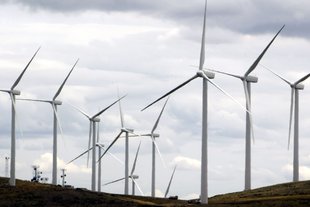forum
library
tutorial
contact

Hydro, Wind Battling for Grid Space
by Christine PrattWenatchee World, April 26, 2011
|
the film forum library tutorial contact |

|
Hydro, Wind Battling for Grid Space
by Christine PrattWenatchee World, April 26, 2011 |
Each is producing to excess, tilting legal balance of power
 WENATCHEE -- When the region's hydro and wind power plants are producing more electricity than customers need, which should have to power down to ensure the grid's mandatory balance of supply and demand?
WENATCHEE -- When the region's hydro and wind power plants are producing more electricity than customers need, which should have to power down to ensure the grid's mandatory balance of supply and demand?
Depends on whom you ask.
Local PUD officals say it should be wind because:
"This is the unintended consequence of not thinking through all these federal laws," says Gregg Carrington, director of energy resources for the Chelan County PUD, which holds federal licenses to operate three dams. "It does not make sense to shut down, so someone can pay $100 a megawatt hour."
Don't be so fast to dismiss wind, just because it costs more, says Rachel Shimshak, executive director of Renewable Northwest Project.
This Portland-based advocacy group seeks to replace with renewable wind, solar, geothermal or tidal energy the small but growing share of the Northwest's market supplied by dirtier sources like coal and natural gas.
"The hydro system was built in the 1930s. You'd expect it to be lower cost than wind," Shimshak says. "The wind projects have identified their customers and have agreements to deliver a certain amount of energy. Excess energy from hydro is just in the market (not needed to serve their local customers). That's a different situation than the wind projects are in."
In December, the Bonneville Power Administration issued a policy proposal that would have required non-hydro generating plants, including wind, to shut down in times of extreme overgeneration. This would allow federal dams to keep generating to reduce the dangers to fish from overspill.
Bonneville markets the power produced by 31 federal dams on the Columbia and operates and maintains about three-fourths of the high-voltage transmission in the western U.S.
As the region's largest "balancing authority," it's the gatekeeper, charged with ensuring blackouts don't happen because of an overtaxed transmission grid.
"Supply and demand have to balance. We cannot take lightly or jeopardize any of our environmental constraints," said Kevin Nordt, director of power management at Grant County PUD. "Bonneville is working very hard to try to come up with a fair and equitable solution."
Bonneville has backed off its hard-line stance following months of public comment, which included strong opposition by wind advocates, and pledged to order temporary wind shutdowns only as a last resort.
"The BPA believes it has the authority to tell wind power to shut down," said Bonneville spokesman Doug Johnson.
It's never done that before, he said, but with above-average riverflows predicted for the first time in years, this could be the year.
"We know the potential is there for this to happen -- to reach a point where we'll have to substitute all forms of electricity connected to the power system with hydropower," he said.
Since 2008, the agency has made big investments in equipment and staff to become better at predicting when and how hard the wind will blow.
This year, it's rescheduled maintenance on its transmission lines, sought additional spill from some federal dams, negotiated an earlier refueling shutdown at the Tri Cities nuclear plant -- all to make way for the expected seasonal glut of wind and hydro power and keep its grid in full service.
But experts say these are band-aid solutions for the costly and politically charged real fixes of higher capacity transmission lines and energy storage projects.
"There is a surplus at the moment," Shimshak said. "Everyone contributes to a surplus when the economy is poor. The bottom line is that the system is changing. People need to recognize the changes and plan for them."
She added, "Bonneville will do what its going to do. We just want them to do everything else first."
Related Pages:
Power Peak Could Mean Lowered Income for PUDs by Christine Pratt, Wenatchee World, 4/25/11
PSE's Lower Snake River Wind Project to Boost Power Generation by Cameron Chai, Clean Tech, 4/15/11
Bonneville Power may Shut Down Wind Turbines to Protect Salmon by John Laumer, Treehugger, 4/14/11
Grid Problems Trigger Rolling Wind-Farm Outages in Pacific NW by William Pentland, Forbes, 4/14/11
Wind Turbines Shutdown Possible by David Mance, KAPP TV, 4/13/11
Wind-Power Producers Fight Possible Shutdown of Turbines by Hal Bernton, The Spokesman-Review, 4/10/11
Bonneville Power Plan Creates Buzz in Industry by Bert Caldwell, The Spokesman-Review, 4/10/11
learn more on topics covered in the film
see the video
read the script
learn the songs
discussion forum
